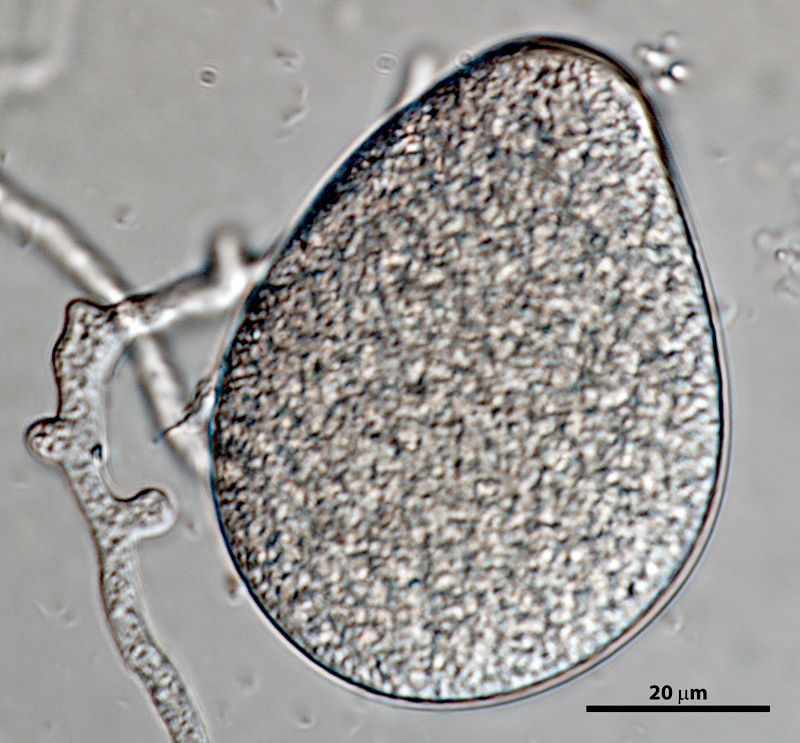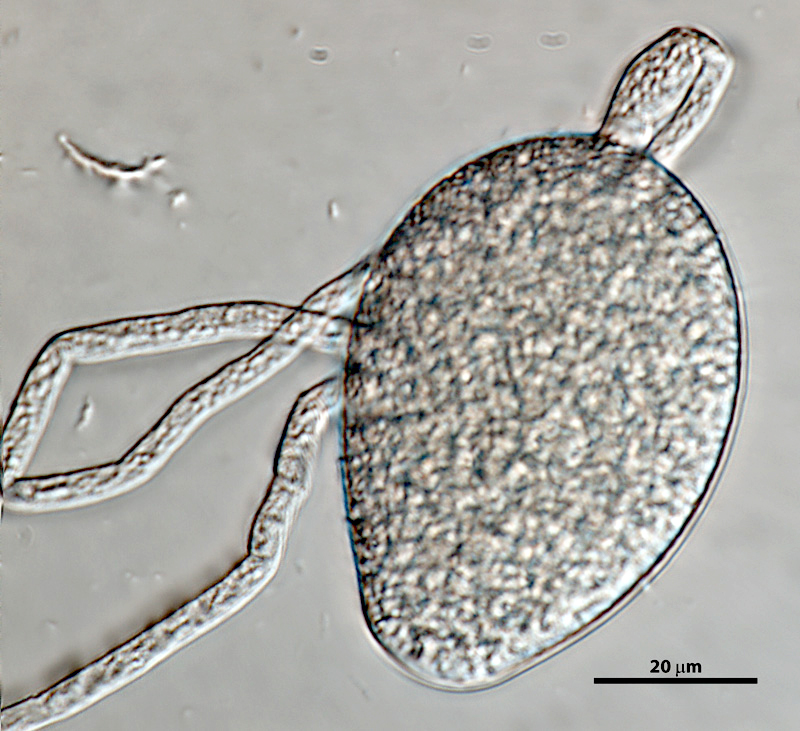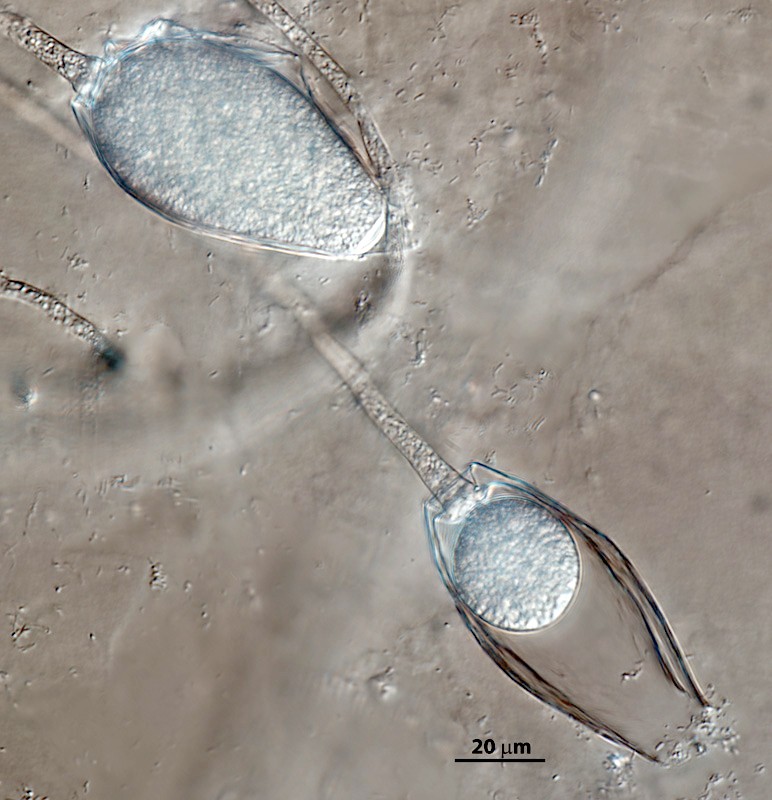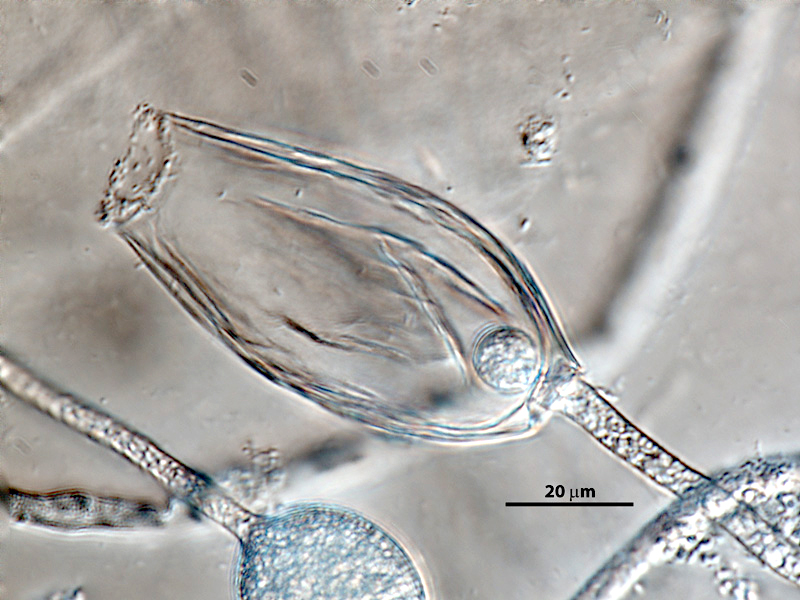Phytophthora fragariae (in progress - Abad et al. 2023b)
|
Phytophthora spp. in subclade 7a: portion of the seven-loci ML phylogeny featuring the type cultures of 212 described species (by T. Bourret). Notice the position of P. fragariae selected specimen CBS 309.62 = S&T BL 213. Gloria Abad, USDA S&T.
|
|
Phytophthora spp. in subclade 7a: Morphological Tabular key (PDF) and Tabular key legends (PDF) in IDphy2 KEY SECTION. Notice the data of P. fragariae selected specimen CBS 309.62 = S&T BL 213. Gloria Abad, USDA S&T.
|
|
Phytophthora fragariae (P10752) asexual phase: (a–d) sporangia nonpapillate, persistent with internal proliferation (c and d); photos by Vickie Brewster, USDA-APHIS-PPQ.
|
|
Phytophthora fragariae (P10752) asexual phase: sporangium nonpapillate, persistent with internal proliferation; photo by Vickie Brewster, USDA-APHIS-PPQ. |
|
Phytophthora fragariae (P10752) asexual phase: sporangium nonpapillate, persistent with internal proliferation; photo by Vickie Brewster, USDA-APHIS-PPQ. |
|
Phytophthora fragariae (P10752) asexual phase: persistent nonpapillate sporangia with internal proliferation; photo by Vickie Brewster, USDA-APHIS-PPQ. |
|
Phytophthora fragariae (P10752) asexual phase: persistent nonpapillate sporangia with internal proliferation; photo by Vickie Brewster, USDA-APHIS-PPQ. |
Name and publication
Phytophthora fragariae Hickman (1940)
Hickman CJ. 1940. The red core root disease of strawberry caused by Phytophthora fragariae n. sp. J. Pomol. Hortic. Sci. 18: 89–118 (pg. 103).
Nomenclature
Mycobank
Typification
from Hickman (1940)
Type: ENGLAND, causing red core root disease of strawberry in Westerham Hill, Kent collected in October 1938 by C. J. Hickman
Ex-type: LOST
Well authenticated specimen(s) selected by Gloria Abad:
CPHST BL 18 = P19539 (WPC) from Fragaria x ananassa, ENGLAND
P10752 (WPC) from Fragaria x ananassa, UNITED STATES OF AMERICA (NCBI ITS rDNA sequence FJ801504)
Selected specimen in other collections
(SE) CBS 309.62, NRRL 64315, ATCC 11107, Hickman R-4, S&T BL 213 (Abad)
Molecular identification
Voucher sequences for barcoding genes (ITS rDNA and COI) of the selected specimen (see Molecular protocols page)
Phytophthora fragariae isolate CPHST BL 18 (= P19539 WPC) = ITS rDNA MG865494, COI MH136890
Voucher sequences for Molecular Toolbox with seven genes (ITS, β-tub, COI, EF1α, HSP90, L10, and YPT1
(see Molecular protocols page) (In Progress)
Voucher sequences for Metabarcoding High-throughput Sequencing (HTS) Technologies [Molecular Operational Taxonomic Unit (MOTU)]
(see Molecular protocols page) (In Progress)
Sequences with multiple genes for selected specimen in other sources
- NCBI: Phytophthora fragariae CPHST BL 18
- NCBI: Phytophthora fragariae CBS 209.46
- EPPO-Q-bank: Phytophthora fragariae CBS 209.46
- BOLDSYSTEMS: Phytophthora fragariae OOMYA044-07 = CBS 209.46 (barcoding COI & ITS)
Position in multigenic phylogeny with 7 genes (ITS, β-tub, COI, EF1α, HSP90, L10, and YPT1)
Clade clade:
a taxonomic group of organisms classified together on the basis of homologous features traced to a common ancestor
7a
Genome sequence
Phytophthora fragariae strain ex-epitype CBS 309.62. Accession genome P.fr2.0, BioProject PRJNA243070, Shenzhen Entry-Exit Inspection and Quarantine Bureau (2018), Gao et al. 2015
Morphological identification
Colonies and cardinal temperatures
Colony colony:
assemblage of hyphae which usually develops form a single source and grows in a coordinated way
morphology after 7 days on CMA, PDA, V-8, with no distinct pattern. Minimum growth temperature 3°C, optimum 18°C, and maximum 27°C.
Asexual phase
SporangiaSporangia:
sac within which zoospores form, especially when water is cooled to about 10°C below ambient temperature; in solid substrates, sporangia usually germinate by germ tubes
nonpapillatenonpapillate:
pertaining to the production of a non-distinct, or inconspicuous, papilla at the distal end of the sporangium (cf. papillate and semipapillate)
; persistentpersistent:
pertaining to sporangia that remain attached to the sporangiophore and do not separate or detach easily (cf. caducous)
; obpyriformobpyriform:
inversely pear-shaped, i.e. with the widest part at the point of attachment (cf. pyriform)
, ovoidovoid:
egg-shaped, with the widest part at the base of the sporangium and the narrow part at the apex
, ellipsoidellipsoid:
refers to a solid body that forms an ellipse in the longitudinal plane and a circle in cross section; many fungal spores are ellipsoidal or elliptic
(28–56 L x 27–49 W µm), often very markedly obpyriformobpyriform:
inversely pear-shaped, i.e. with the widest part at the point of attachment (cf. pyriform)
in shape; with internal and nested proliferationnested proliferation:
a type of internal proliferation where a new sporangium develops successively inside the old sporangium after it has emptied
and originated in unbranched or simple sympodial sporangiophores. Hyphal swellings globoseglobose:
having a rounded form resembling that of a sphere
, subglobose, coralloid, solitary, and catenulatecatenulate:
having a chain-like form
in chains. Chlamydospores absent.
Sexual phase
Homothallichomothallic:
pertaining to sexual reproduction that can take place within a single thallus (i.e. self-fertile, non-outcrossing) (cf. heterothallic).
. Oogonia smooth-walled, originated in very short stalks; frequently globoseglobose:
having a rounded form resembling that of a sphere
(28–46 µm diam) with tapering base; antheridiaantheridia:
the male gametangium; a multinucleate, swollen hyphal tip affixed firmly to the wall of the female gametangium (the oogonium)
paragynousparagynous:
pertaining to the sexual stage in which the antheridium is attached to the side of the oogonium (cf. amphigynous)
or amphigynousamphigynous:
pertaining to the sexual stage in which the antheridium completely surrounds the stalk of the oogonium (cf. paragynous)
(16–30 L x 12–22 W µm); oosporesoospores:
zygote or thick-walled spore that forms within the oogonium after fertilization by the antheridium; may be long-lived
spherical (24–44 µm diam), ellipsoidal, or irregular.
Specimen(s) evaluated
Phytophthora fragariae CPHST BL 18, duplicate of P19539 (World Phytophthora Collection)
Phytophthora fragariae P10752 (WPC)
Hosts and distribution
Distribution: Asia, Australia, New Zealand, Europe, North America (Canada, USA)
Substrate: roots
Disease note: Red stele or red core root rot. The most important fungal pathogen of strawberries (Ho & Jong 1988). Foreign races are listed by APHIS as a regulated plant pest.
Host: Fragaria x ananassa and Rubus ursinus var. longanobaccus (Rosaceae) are the only known hosts under natural conditions. Infection of other Rosaceae, Amaranthaceae, and Solanaceae can occur via artificial inoculation (Erwin 1996).
Retrieved January 30, 2018 from U.S. National Fungus Collections Nomenclature Database.
Additional references and links
- SMML USDA-ARS: Phytophthora fragariae
- EPPO Global Database: Phytophthora fragariae
- Forest Phytophthoras of the world: Phytophthora fragariae
- CABI Digital Library: Phytophthora fragariae
- Encyclopedia of Life (EOL): Phytophthora fragariae
- Index Fungorum (IF): Phytophthora fragariae
- Google All Phytophthora fragariae
- Google Images Phytophthora fragariae
- Google Scholar Phytophthora fragariae
Fact sheet author
Z. Gloria Abad, Ph.D., USDA-APHIS-PPQ-S&T Plant Pathogen Confirmatory Diagnostics Laboratory (PPCDL), United States of America.






